 Image search results - "year" Image search results - "year" |

Nagahama Hachimangu Shrine torii on New Year's Day. Nagahama's most popular shrine for New Year's worship (hatsumode). MAP
|
|

Tokyo Shiga Kenjinkai New Year's Party 2007 平成19年 東京滋賀県人会 新年賀詞交歓会Party fee was 7,000 yen.
|
|

National Diet members in Tokyo representing Shiga Prefecture. 滋賀の議員
|
|

Path to shrine with stone lanterns, and cars.
|
|

Each Diet member gave a short speech.
|
|

Stone lanterns
|
|
|
|

Buffet dinner in Providence Hall, Tokyo Prince Hotel
|
|

The shrine grounds was filled with cars on New Year's Day. Apparently, the shrine has no parking lot.
|
|

Buffet
|
|

Another entrance to the shrine
|
|

Mochi-tsuki 餅つき大会
|
|
|

Mochi for all, dressing was grated daikon and dried bonito shavings.
|
|
|

Live orchestra playing swing jazz. 有川新二&ザ・グレイ・ラスカルズオーケストラ「なつかしのスウイングジャズ」
|
|

Haiden hall 拝殿
|
|

Drawing for prizes donated by Shiga businesses. 抽選会
|
|

Ice sculpture of two rats. 2008 is the year of the rat.
|
|

Prizes. 抽選会の景品
|
|
|

People come to claim their prizes. 景品を受ける
|
|

Honden Hall 本殿
|
|

Consolation prize for people who didn't win anything. 当たらなかった人にも残り少々の景品
|
|

New Year's prayers amid snow.
|
|

Singing "Biwako Shuko no Uta" 琵琶湖周航の歌
|
|

Buying omikuji fortune paper
|
|

Singing "Biwako Shuko no Uta"
|
|

Shrine souvenirs
|
|

Singing "Biwako Shuko no Uta" in a large circle.
|
|

Votive tablet
|
|

Banzai
|
|
|

Everyone got to take home a gift bag of negi green onions, mochi, and other goodies.
|
|
|

Gift bags.
|
|

Torii to Benzaiten Shrine
|
|

Benzaiten Shrine
|
|

Benzaiten Shrine
|
|

Torii to Tenmangu Shrine 天満宮
|
|

Tenmangu Shrine 天満宮
|
|

Crowd during New Year's
|
|

I always visit a different shrine on New Year's Day, so for 2009, I visited Atsuta Jingu Shrine in Nagoya. JR Atsuta Station on the Tokaido Line is one train station near Atsuta Jingu Shrine. JR熱田駅
|
|

Shopping arcade on the way to the shrine from Atsuta Station.Atsuta Jingu is near Meitetsu Jingumae Station, JR Atsuta Station on the Tokaido Line, Atsuta Jingu Nishi Station (renamed from Jingu Nishi Station on Jan. 4, 2023) on the Meijo subway line, and Atsuta Jingu Tenma-cho Station (renamed from Tenma-choStation on Jan. 4, 2023) on the Meijo subway line.
|
|

Another train station near Atsuta Shrine is Meitetsu Jingumae Station (this is closer than Atsuta Station). 名鉄神宮前駅
|
|

The road in front of Meitetsu Jingumae Station was closed to traffic, allowing pedestrians to get to Atsuta Shrine on New Year's Day.
|
|

Atsuta Jingu is one of Japan's most important shrines as it enshrines one of the three Imperial Regalia of Japan, the sacred (and perhaps legendary) sword called Kusanagi-no-Tsurugi ("Grass Cutting Sword"). 草薙の剣
|
|

Many food stalls line the way to the shrine on New Year's Day.
|
|

One normal gate was closed and we all had to enter through the East Gate.
|
|

The East torii gate of Atsuta Jingu Shrine, made of wood. Atsuta Jingu worships Atsuta-no-Ookami or Amaterasu-Omikami, the Sun Goddess represented by Kusanagi-no-tsurugi, the sacred sword.
|
|

This is where the crowd begins on New Year's Day. The shrine also worships four other deities: Susanoo-no-mikoto, Yamato-Takeru-no-Mikoto, and Takeinadane-no-Mikoto and Miyasuhime-no-Mikoto, the parents of the Owari natives (Nagoya area).
|
|

Banner read "Happy New Year."
|
|

Atsuta Shrine was established about 1900 years ago. In the centuries past, the shrine has been patronized by major historical figures such as Oda Nobunaga, Toyotomi Hideyoshi, and the Tokugawa shoguns (Ieyasu was originally from this area).
|
|

We soon hit a bottleneck where we had to wait a while as we slowly got nearer to the shrine.
|
|

We got to the wash fountain to purify ourselves.
|
|

From the ladle, pour the water into your hand and sip the water to purify yourself before visiting the shrine. This was a most crowded place.
|
|

Wash fountain
|
|

The crowd thickens and it was stop and go, repeatedly.
|
|

Barrels of sake.
|
|

We stand still.
|
|

We want to go straight.
|
|

Finally, the shrine is in sight.
|
|

Approaching the final torii.
|
|

The police were holding back the crowd at regular intervals before they could enter the shrine's worship area.
|
|

Now we stand in line to pray before the shrine.
|
|

Standing in line to pray.
|
|
|

Getting closer.
|
|
|

This is what we wanted to see. The offertory pit where people throw their money in front of the Hongu main shrine. 本宮
|
|

New Year's prayers at Atsuta Jingu Shrine on Jan. 1.
|
|
|
|

Coins, bills, gift certificates, and even wallets were thrown in here.
|
|
|
|

The shrine's bank will love to count all this money. It must be their favorite time of year.
|
|

I wonder how much money these wallets contain.
|
|

View of the money pit as seen from the shrine. This is still quite small compared to Meiji Shrine in Tokyo on New Year's Day. Less crowded too.
|
|

Atsuta Jingu Shrine's Hongu main shrine. For 1,000 yen, they let you in here to pray. The architecture and layout are almost the same as the Ise Grand Shrines in Mie Pref. Rebuilt in 1955. I wonder if the sacred sword is in there.
|
|

They also give you a small dish and sake served by a shrine maiden as you exit.
|
|

This is what we received for 1,000 yen. Some sweets as well. It also included a tea session. (See below.)
|
|

Shrine amulets were selling like crazy.
|
|

Shrines are in the business of selling good fortune and hope.
|
|

Votive tablets and other trinkets.
|
|
|
|

Description of various amulets in English.
|
|
|
|
|
|

Omikuji fortune paper.
|
|

Built in 1686 by Shogun Tsunayoshi, this is Nishi-gakusho, one of the few shrine buildings remaining from before the Meiji Period. Dances and other ceremonies are held here. 西楽所
|
|

Remnant of the Nobunaga-bei, a roofed mud wall donated to the shrine in 1560 by Oda Nobunaga in gratitude for his victory at the Battle of Okehazama.
|
|

Follow the sign to exit or to see other shrine buildings.
|
|

Homotsukan Treasure Hall houses and exhibits the shrine's valuable artifacts, including Important Cultural Properties and a National Treasure (a dagger). Many people donated stuff to the shrine, especially swords. 宝物館
|
|

Behind and attached to the Homotsukan Treasure Hall is the Bunkaden Culture Hall where they held a tea session. People form a long line as they wait to enter the Bunkaden. The tea was included in the 1,000 yen I paid to see the inner shrine.
|
|

This is the Bunkaden Culture Hall which is behind and attached to the Treasure Hall. This is where they held the tea session.
|
|

Inside the Bunkaden Culture Hall for tea.
|
|

The stage was appropriate for New Year's.
|
|

There was no ceremony. We just sat and were served tea and sweet.
|
|

A sweet confection to eat with the matcha tea.
|
|

The shrine maidens came around to serve the tea and sweet.
|
|

My bowl of matcha green tea. After we consumed the tea, we just left. The shrines also has many other buildings, but it was too crowded for me to see them all this day. I was too tired walk around more.
|
|
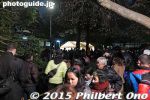
On New Year's Eve, Gotokuji temple allows people to ring the temple bell to ring out the old year in a ceremony called Joya-no-kane.
|
|
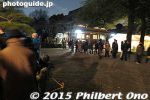
The line of people got longer and longer as midnight approached.
|
|
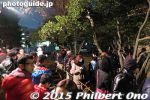
Quite a few people braved the cold to ring the temple bell on New Year's Eve on Dec. 31, 2014.
|
|
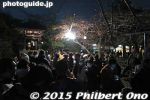
Temple bell in sight. Had to wait about an hour.
|
|
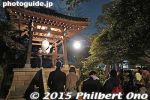
Gotokuji's temple bell on New Year's Eve.
|
|

Ringing Gotokuji's temple bell on New Year's Eve.
|
|

Each person got to ring the bell only once.
|
|
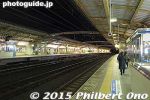
Gotokuji Station on early New Year's morning.
|
|
|
|
|
|
|
|
|
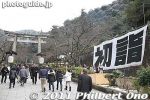
Sign reads, "Hatsumode" or New Year's worship.
|
|
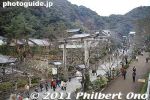
The first torii to the shrine.
|
|
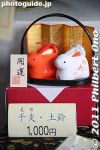
For the Year of the Rabbit.
|
|
|
|
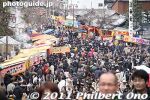
Pretty crowded, but it proceeded smoothly.
|
|
|
|
|
|
|
|
|
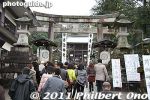
From here, we had to wait in line.
|
|

The second torii.
|
|
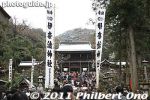
Banners read Inaba Shrine.
|
|
|
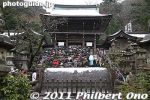
Arched bridge too steep to cross over.
|
|
|
|
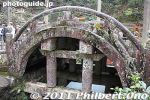
Inaba Shrine's taiko bridge. 神橋
|
|
|
|
|
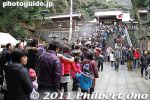
We had to wait a while...
|
|
|
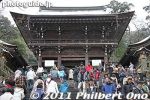
Romon Gate 楼門
|
|
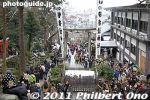
View from Romon Gate.
|
|
|
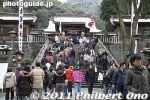
The line proceeded fast enough.
|
|
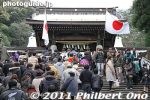
Approaching another gate called Shinmon. 神門
|
|
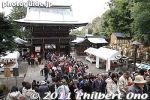
View of Romon Gate from Shinmon Gate.
|
|

Inaba Shrine's Haiden Hall was where we could pray.
|
|

Lining up to pray at Haiden Hall.
|
|
|
|

Inside Inaba Shrine's Haiden Hall.
|
|

Offertory box
|
|
|
|
|

People buying good luck charms.
|
|
|
|
|
|
|
|
|
|
|
|
|
|
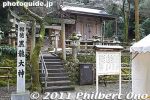
Inaba Shrine has a few other lesser shrines.
|
|
|
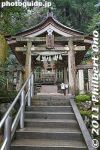
黒龍社
|
|

Romon Gate side view.
|
|
|
|
|
|
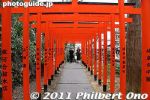
Inari Shrine torii. 楓稲荷神社
|
|
|
|
|
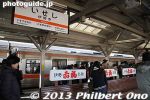
Ise-shi Station platform upon arrival on Jan. 1, 2013. Ise Jingu's Geku Outer Shrine is a short walk from this station.
|
|
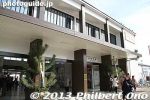
Ise-shi Station with kadomatsu New Year's decorations.
|
|
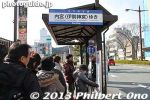
Bus stop for Naiku Inner Shrine. This is near Ise-shi Station.
|
|
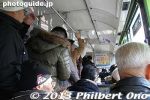
Inside the bus going to Naiku from Ise-shi Station.
|
|
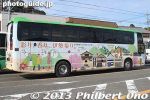
Colorful bus at Ise.
|
|

Bus with motif promoting Ise. Going to worship at Ise Jingu is called "Ise-mairi."
|
|
|
|

Map of Ise Jingu's Naiku Shrine. First you cross Uji Bridge.
|
|
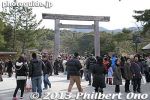
Torii gate at Uji Bridge. Very crowded with New Year's worshippers going for hatsumode prayers.
|
|
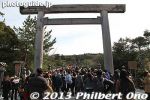
Ise Jingu Shrine's Naiku (Inner Shrine) is the main and most popular shrine at Ise. The shrine is rebuilt every 20 years and 2013 will mark the completion of the new shrine to replace the old one built in 1993.
|
|

Ise Jingu Shrine's Naiku is officially named, "Kotaijingu" (皇大神宮). It worships Amaterasu Omikami 天照坐皇大御神, the ancestor of the Imperial Family and the tutelary kami of the Japanese people. Naiku was founded 2000 years a
|
|

Crossing Uji Bridge, a little over 100 meters long. 宇治橋
|
|

A guard watching over the crowd crossing Uji Bridge.
|
|
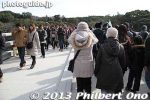
Uji Bridge is also rebuilt every 20 years.
|
|
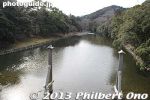
Uji Bridge goes over Isuzu River. 五十鈴川
|
|
|

The other end of Uji Bridge also has a torii gate.
|
|
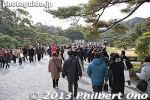
After crossing Uji Bridge, it is a gravel path to the shrine.
|
|
|
|
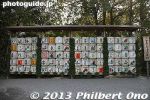
Barrels of sake as offerings.
|
|
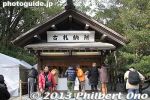
Place to dispose of old decorations bought from the shrine.
|
|
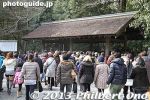
Water fountain where you wash your hands and rinse your mouth for purification. 手水舎
|
|
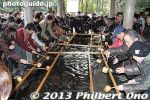
Before praying at the shrine, you're supposed to purify yourself. Wash your hands and rinse your mouth here. Use the ladle to pour water into your hand, then sip the water from your hand. Don't sip the water directly from the ladle. 手水舎
|
|

The first torii or Daiichi torii.
|
|
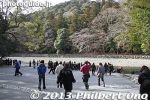
Another place to purify yourself on the banks of Isuzu River at this place called the Mitarashi. 五十鈴川と御手洗場
|
|

Dip your hands here in Isuzu River. Auto maker Isuzu was named after this crystal-clear river. 五十鈴川と御手洗場
|
|

We could easily proceed from Uji Bridge to this Daini (Second) torii. So far so good.
|
|
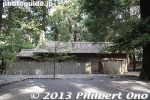
Horse stable.
|
|
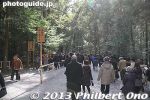
Still walking at a good pace.
|
|
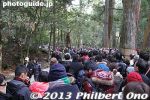
About 300-400 meters to the Naiku shrine, it got congested. It took about an hour to reach the foot of the steps going up to the shrine.
|
|
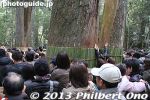
Bamboo strips protect the trees.
|
|

This is the steps leading to the new Naiku shrine that will be completed this fall 2013. The shrine buildings are already close to completion, but they are covered up.
|
|

Lot of people here, but it's still not as crowded as Meiji Shrine in Tokyo.
|
|
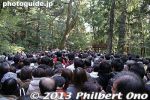
I could see the heatwaves from the people's bodies. Still inching forward.
|
|
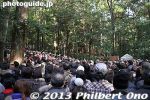
Getting closer to the bottom of the steps leading up to the Naiku shrine.
|
|
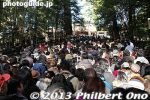
Naiku shrine and torii are in sight at the top of the steps ahead. We were told that it would take more than an hour just to get up these steps. However, we could walk up the steps quickly on the right edge of the steps.
|
|

On the steps going up to Naiku shrine. This was where it got ridiculous. Literally a snail's pace.
|
|
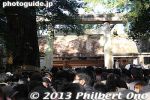
Naiku torii at the top of the steps.
|
|
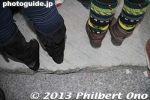
At the bottom of the steps going up to the shrine.
|
|

Close up map of Naiku. An adjacent plot next the shrine is for the next rebuilding of the shrine. The current, 20-year-old Naiku shrine is on an adjacent plot of land. It takes 8 years to rebuild the Naiku shrine. So 12 years from now, they will start the rebuilding process all over again. Numerous ceremonies are held for this rebuilding, but only a few of them can be seen by the public.
|
|
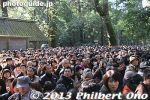
People behind me.
|
|
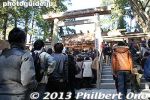
The bottleneck at Naiku was this little torii which most people wanted to walk through at the top of the steps. People like me who didn't have time opted to go up the steps on the right side in no time.
|
|
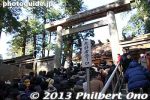
We didn't get to go through the torii, but it wasn't worth the wait. They never explained the difference between staying in the middle of the steps and going up on the right edge.
|
|
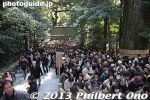
The scene from the top of the steps. People on the right are aiming for the torii. People on the left are shooting up the steps in no time.
|
|

Naiku's bottleneck. These people took at least an hour to climb up the steps to go through this little torii. So it must've taken them at least 2 hours to get here from Uji Bridge. Normally it's a 10-15 min. walk.
|
|

The people who went up the right edge of the steps didn't go through the torii and could only pray at a temporary, off-center position under the slim roof seen here on the right of the thatched-roof gate.
|
|
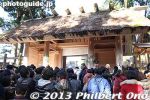
After going through the torii, they could pray at this center position under this thatched-roof gate in front of the shrine.
|
|
|
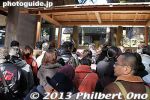
There was a money box under both the thatched roof and under the slim roof structure next to it. Either way, you can still pray at the shrine. Not a big deal if you don't go through the torii or don't pray from the center spot under the thatchedIt really looked like the people going up on the right edge were exiting without praying at the shrine. Not so. They could also pray at the shrine, but at an off-center position.
|
|
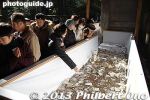
Look how small the offertory box is at Ise Jingu's Naiku. The one at Meiji Shrine in Tokyo is like half the size of a football field. Of course, Ise Jingu just doesn't have the space for it.
|
|
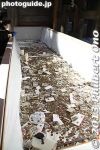
Small offertory box.
|
|

My video of Ise Jingu Naiku on Jan. 1, 2013.
|
|
|
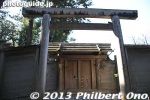
Side torii gate at Naiku.
|
|

High walls prevent us from seeing the sacred shrine buildings of Naiku. Photography is not allowed inside these walls so don't try to use a long pole with a camera attached to take pictures. There are guards everywhere.
|
|
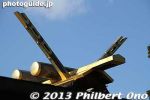
Roof horns at Ise Jingu's Naiku.
|
|
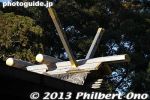
This is all we can see of the main shrine building called the Shoden (正殿), the home of Amaterasu. The design of the shrine buildings are especially beautiful and awe-inspiring. Too bad we can't see it. There are photographs (especially by Yoshio
|
|
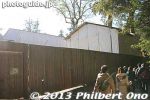
It takes 8 years to rebuild the Naiku shrine. So 12 years from now, they will start the rebuilding process all over again. Numerous ceremonies are held for this rebuilding, but only a few of them can be seen by the public.
|
|
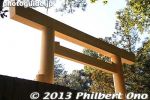
Brand new wooden torii.
|
|
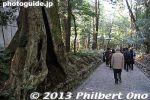
Way back.
|
|
|
|
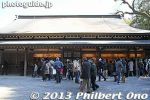
Shrine gift shop for amulets etc. Make no doubt, religion in Japan is very big business. They are in the business of selling hopes, dreams, prayers, ceremonies, and amulets.
|
|

The great thing for them is that they need not provide any guarantee that your hopes, dreams, and prayers will come true for you. No such thing as a product warranty nor money-back guarantee.
|
|
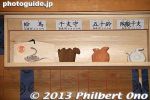
Snake souvenirs for sale. Major Shinto shrines make much of their income during New Year's.
|
|
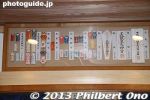
Imagine providing a service or product for which you need not worry about complaints, defects, malfunctions, errors, or failures. And the customer base is guaranteed forever.
|
|
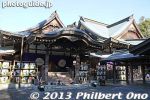
Kaguraden hall for sacred dances and prayers. 内宮神楽殿
|
|
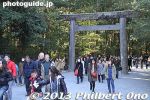
People still streaming toward Naiku shrine passing through the second torii.
|
|
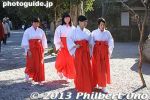
Ise Jingu shrine maidens look the same as any other shrine maidens. They are likely college students hired just for New Year's to sell goods.
|
|
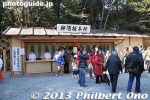
A sip of sake at this booth. I saw no indications of a fee for this sake, but there was a donation tray right there.
|
|
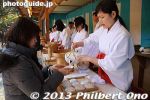
I wondered how much I should donate for this sake. I just dropped a 100 yen coin and probably got 20 yen worth of sake. At Atsuta Shrine (one of Japan's Big Three shrines) in Nagoya, they have a nice big hall where they serve hot tea and sweets for Nothing like that here.
|
|

Sanshuden rest house
|
|
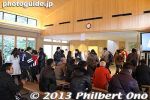
Inside Sanshuden rest house, a nice warm place to rest.
|
|

They served free green tea.
|
|

THe rest house had a view of a Noh stage.
|
|
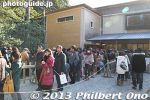
Much more popular than sake was amazake (sweet sake). This line was too long for me so I skipped it.
|
|
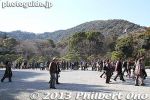
Where the people coming and going converge at Ise Jingu's Naiku.
|
|
|
|
|